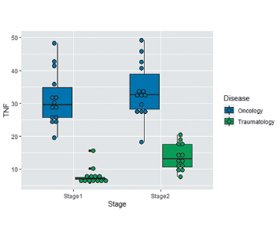Журнал «Здоровье ребенка» Том 18, №2, 2023
Вернуться к номеру
Порівняльне дослідження знеболювальної та антистресової дії інгаляційної анестезії у дітей з онкологічною та травматологічною патологією при хірургічному лікуванні
Авторы: Снісарь В.І., Миронов Д.В.
Дніпровський державний медичний університет, м. Дніпро, Україна
Рубрики: Педиатрия/Неонатология
Разделы: Клинические исследования
Версия для печати
Актуальність. Велике значення для безпеки пацієнта має адекватна анестезія, що знижує стресові реакції на операцію і травму. Досконалість сучасної анестезії дозволяє проводити складні операції в різних вікових періодах у пацієнтів з високим хірургічним та анестезіологічним ризиком. Для обмеження активації нейроендокринних, запальних та імунних реакцій під час хірургічного втручання постійно проводять пошук нових методик анестезії, порівнюються різні інгаляційні та неінгаляційні препарати для наркозу з метою знайти ідеальний «безстресовий» анестетик. На сьогодні під час операції з приводу раку широко використовується севофлюран, проте існує недостатньо досліджень, що показують ефективність цього інгаляційного анестетика у дітей при хірургічному лікуванні пухлин і його вплив на операційну травму та реакцію дитячого організму на стрес. Мета дослідження. Мета нашого дослідження полягає в тому, щоб вивчити, наскільки севофлюран обмежує активацію нейровегетативних, запальних та імунних реакцій дитячого організму при хірургії онкологічних захворювань. Матеріали та методи. Було обстежено 27 дітей (перша група) віком від 1 до 17 років (6,04 ± 5,84 року), які надійшли для хірургічного лікування онкологічних захворювань. Для порівняння досліджуваних показників додатково було обстежено 23 дитини (друга група) віком від 2 до 17 років (10,68 ± 4,21 року), яким планувалося оперативне лікування з приводу травматологічної патології. Результати. Оцінка адекватності анестезії севофлюраном під час операції в онкологічних та травматологічних хворих показала, що більшість параметрів гемодинаміки мали подібні зміни на всіх етапах, що характерні для севофлюранової анестезії. Нами вивчені зміни С-реактивного білка та циркулюючих цитокінів до та після анестезії севофлюраном у дітей з онкологічною та травматологічною патологією. Рівень С-реактивного білка збільшився в 4 рази, але спочатку його рівень був у 2–2,5 раза більше в онкологічних хворих. Аналогічна динаміка була продемонстрована і щодо прозапальних цитокінів (IЛ-6 та TNF). Наприкінці оперативного втручання відзначалося значне зростання кортизолу, проте в дітей другої групи рівень цього гормону зростав більше порівняно з онкологічними хворими. Усі спектральні показники варіабельності серцевого ритму, які свідчили про напруження вегетативної нервової системи, мали вірогідну різницю між групами. Висновки. При інгаляційній анестезії севофлюраном профіль реакції на стрес у дітей з онкологічною патологією відрізняється від такого у пацієнтів з травмами.
Background. Adequate anesthesia is of great importance for patient safety, it reduces stress reactions to surgery and trauma. The perfection of modern anesthesia allows performing complex operations in different age periods in patients at high surgical and anesthetic risk. To limit the activation of neuroendocrine, inflammatory and immune reactions during surgery, new methods of anesthesia are constantly being searched for, different inhalation and non-inhalation drugs for anesthesia are compared in order to find an ideal “stress-free” anesthetic. Currently, during cancer surgeries, sevoflurane is widely used, but there are few studies showing efficiency of this inhalation anesthetic in children during surgical treatment of tumors and its effect on operative trauma and the reaction of the child’s body to stress. The purpose of our research is to study the extent to which sevoflurane limits the activation of neurovegetative, inflammatory, and immune responses in children during cancer surgery. Materials and methods. Twenty-seven children (first group) aged from 1 to 17 years (6.04 ± 5.84 years), who came for surgical treatment of cancer, were examined. To compare the studied indicators, 23 children (second group) aged from 2 to 17 years (10.68 ± 4.21 years) were additionally examined, they were scheduled for surgical treatment of trauma pathology. Results. Evaluation of the adequacy of sevoflurane anesthesia during operations in cancer and trauma patients showed that most hemodynamic parameters had similar changes at all stages, which is typical for this type of anesthesia. We studied changes in C-reactive protein and circulating cytokines before and after anesthesia with sevoflurane in children with cancer and trauma pathology. C-reactive protein level increased 4 times, but initially its level was 2–2.5 times higher in cancer patients. Similar dynamics was demonstrated with pro-inflammatory cytokines (interleukin-6 and tumor necrosis factor). By the end of surgical intervention, a significant increase of cortisol was noted; however, in the children of the second group, the level of this hormone increased more compared with cancer patients. All spectral indicators of heart rate variability, which testified to the tension of the autonomic nervous system, had a significant difference between the groups. Conclusions. During inhalation anesthesia with sevoflurane, the profile of stress response in children with cancer differs from that in patients with trauma pathology.
діти; онкологічна та травматологічна патологія; анестезія; севофлюран
children; cancer and trauma pathology; anesthesia; sevoflurane

